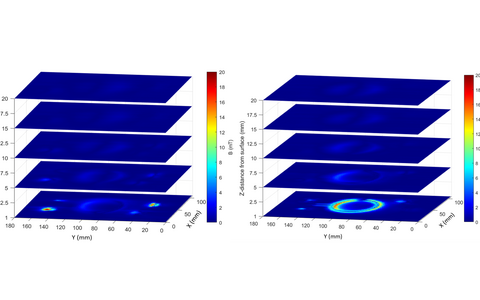With pacemaker simply flip the iPhone
Together with Dr. Florian Blaschke and Dr. Philipp Lacour from Charité – Universitätsmedizin Berlin, you tested how much distance should be kept between iPhone 12 models and implanted pacemakers. What did you find out?
Thoralf Niendorf: First let me give some background into our study: The FDA, the U.S. regulatory agency for drugs and medical devices, warns that the iPhones 12 and 13 pose a risk for people with cardiac implantable electronic devices (CIEDs) such as pacemakers and cardioverter defibrillators. Apple itself recommends keeping these iPhone models at least 15 centimeters (6 inches) away from CIEDs. That’s because smartphones of this generation have a circular magnet built into them that attaches the phone to the charging base and enables wireless charging.
There are concerns that this magnetic field could interfere with the function of CIEDs. During the approval process, pacemaker and cardioverter defibrillator manufacturers must prove that their devices can operate properly in static magnetic field strengths of up to 1 millitesla. We wanted to know at what point the phones’ circular magnets would exceed this 1-millitesla limit, interfering with the functioning of CIEDs and causing them to revert to default factory settings. When the front of the phone is facing the CIED, the magnetic field exceeds the 1-millitesla limit at a distance of a little more than 1 centimeter. But the magnet is built into the back of the phone. Here the magnetic field is a bit stronger and exceeds the 1-millitesla limit at a distance of up to 17 millimeters.
Separation distance of 15 centimeters is excessive
How deep is a CIED implanted?
Pacemakers and cardioverter defibrillators are implanted in the chest underneath the skin. So there is a good two centimeters of tissue between the CIED and the iPhone. You also have to factor in layers of clothing. This means the minimum separation distance of 15 centimeters is excessive.
What is your recommendation?
If you want to be on the safe side, you should put your iPhone in your breast pocket with the screen facing your body.
Magnetic interactions between the smartphone and the CIED only occur when they are exactly on top of each other. If the back of the smartphone is pointing in the direction of the pacemaker or other cardiac implant, the stray magnetic field of the smartphone reaches farther and is stronger. On the front of the phone, the critical 1-millitesla limit of the stray field is undercut already at a distance of 1 centimeter. People with CIEDs should therefore not put their iPhone directly on the skin above the implanted device. If you want to be on the safe side, you should put your iPhone in your breast pocket with the screen facing your body. No other precautions are necessary. That’s why we’ve gave our paper the subtitle “Flip it to be safe” – as a bit of practical advice.
No cell phone is no solution
You would think that companies would tend to downplay the risks. Is it a bad thing that Apple is being overly cautious here?
At first glance it doesn’t seem bad. But the company’s recommendation unsettles patients. They’re afraid that their cell phone will put them in danger, so they would rather not use one. On the other hand, we have also heard from patients who said they would rather do without a pacemaker than their cell phone. Both can have fatal consequences. Apple should change its recommendation. It raises unnecessary concerns.
How were the measurements taken?
My research group deals with experimental ultrahigh field magnetic resonance imaging. Our devices generate magnetic fields with a field strength of up to 9.4 tesla. The iPhone produces stray magnetic fields on the order of millitesla – that is, one thousandth of a tesla. However, we have developed automated measuring stations and equipment that are so sensitive that we can precisely measure even the relatively weak stray magnetic fields of a cell phone. We can even visualize them spatially. That’s exactly what we did, and we were able to measure precisely the distance at which the magnetic field strengths of the smartphones can influence the CIEDs.
The iPhone's magnetic field exceeds the one-millitesla limit at a distance of about one centimeter on the front (left); on the back, where the magnet is located, this limit is about 1.7 centimeters.
Only very thin people need to be careful
Did you also measure the human participants?
Yes, clinical measurements were done by colleagues at Charité. They brought the front and back of the smartphone close to the upper body of the test subjects, a total of 164 patients with CIEDs. They were only able to detect an interaction in very slim subjects.
More and more devices contain magnets, such as tablets, headphones, razors, work lamps and so-called rust repellents for use in dishwashers. No one warns about these devices. Is the danger underestimated?
It would definitely be good if manufacturers were required to inform consumers of the magnetic field strength of their products.
Text: Jana Ehrhardt-Joswig
Further information
Literature
Philipp Lacour et al (2021): Magnetic field–induced interactions between phones containing magnets and cardiovascular implantable electronic devices: Flip it to be safe? In: Heart Rhythm, DOI: https://doi.org/10.1016/j.hrthm.2021.11.010







